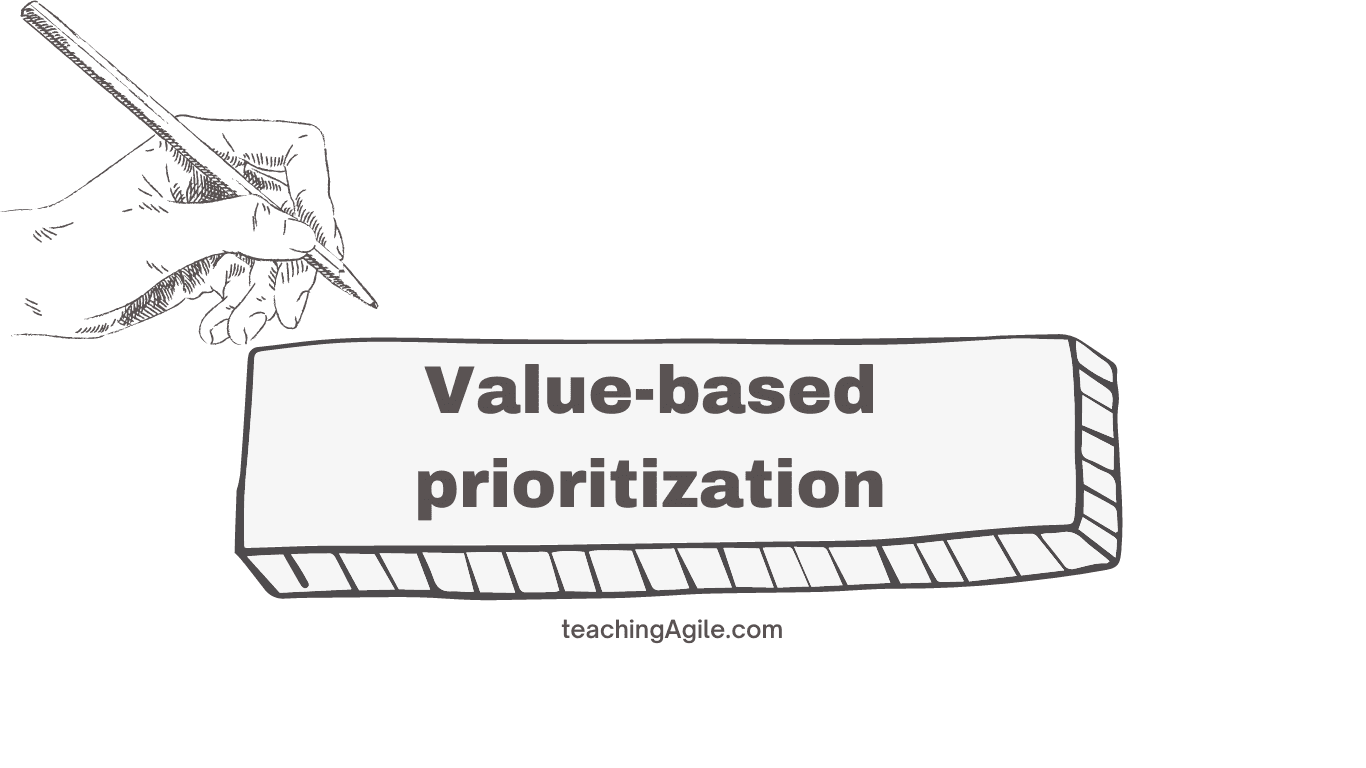
Mastering Value-Based Prioritization: A Guide to Boosting Project Success
 Mastering Value-Based Prioritization
Mastering Value-Based Prioritization
Value-based prioritization means ordering work by its potential value to customers, stakeholders, and the organization.
Teams deliver highest-value items first.
This maximizes return on investment and accelerates value realization.
This approach differs fundamentally from traditional prioritization.
Traditional projects prioritize by loudest stakeholder, technical dependencies, or arbitrary deadlines.
Value-based prioritization uses objective criteria: customer impact, revenue potential, strategic alignment, cost of delay.
Scrum mandates value-based prioritization through the Product Owner accountability.
Product Owners order the Product Backlog by value.
They decide what the Developers work on next based on value maximization.
Top-of-backlog items represent the most valuable work the team could do right now.
Key characteristics: Value-based prioritization requires defining "value" explicitly.
Value can mean: customer satisfaction increase, revenue generation, cost reduction, risk mitigation, strategic goal advancement, learning enablement.
Different contexts emphasize different value dimensions.
Product Owners synthesize multiple value perspectives into single prioritization.
Prioritization techniques provide frameworks for value assessment.
MoSCoW method categorizes by necessity: Must have, Should have, Could have, Won't have.
Kano Model analyzes customer satisfaction impact: Basic needs, Performance needs, Delighters.
Weighted Shortest Job First (WSJF) calculates cost of delay divided by duration.
Each technique helps quantify subjective value judgments.
Critical insight: Value-based prioritization enables empiricism in action.
Teams deliver valuable Increments early in development.
Stakeholders provide feedback on actual working features.
Teams learn what customers truly value (not what they said they'd value).
Product Owners continuously re-prioritize based on emerging value insights.
This creates value discovery process, not just value delivery.
Value-based prioritization transforms the Product Backlog from task list to strategic value optimization tool.
Quick Answer: Value-Based vs Traditional Prioritization
| Aspect | Value-Based Prioritization (Scrum) | Traditional Prioritization |
|---|---|---|
| Decision Basis | Customer value, business impact, ROI, cost of delay | Technical dependencies, stakeholder pressure, arbitrary deadlines |
| Who Decides | Product Owner synthesizes stakeholder input and orders backlog | Project manager or committee based on plan |
| When Prioritized | Continuously re-prioritized based on learning and feedback | Fixed at project start, changes require formal process |
| Value Definition | Explicit criteria: revenue, satisfaction, strategic alignment, cost reduction | Often implicit or undefined |
| Prioritization Frequency | Every Sprint, sometimes mid-Sprint based on inspection | Infrequent re-planning cycles (quarterly, annually) |
| Flexibility | High—Product Owner can reorder backlog anytime | Low—scope changes require change control |
| Techniques | MoSCoW, Kano Model, WSJF, Business Value points | Gantt charts, critical path, resource availability |
| Outcome | Maximum value delivered early, empirical value discovery | Predictable delivery of original scope |
Table Of Contents-
What is Value-Based Prioritization?
Value-based prioritization is a project management technique that involves prioritizing tasks, features, or user stories based on their potential value to the customers, stakeholders, or the organization.
This approach ensures that teams focus on delivering the most valuable items first, maximizing the return on investment (ROI) and customer satisfaction.
The Importance of Value-Based Prioritization
Value-based prioritization plays a crucial role in project management for several reasons:
- Maximizes ROI: By focusing on high-value items, teams can generate the maximum return on investment for their allocated resources.
- Improves Customer Satisfaction: Prioritizing features that deliver the most value to customers helps meet their needs and expectations more effectively.
- Enhances Team Efficiency: By focusing on high-value tasks or features first, teams can work more efficiently, delivering impactful results quickly. This prioritization approach helps avoid wasted time on low-value tasks, streamlining the development process and increasing overall productivity.
- Prioritizes Limited Resources: Teams often face time, budget, or human resources constraints. Value-based prioritization helps allocate these limited resources wisely to yield the best results.
- Supports Agile Development: Agile methodologies like Scrum advocate for value-based prioritization to ensure a consistent focus on delivering customer value iteratively and incrementally.
How to Implement Value-Based Prioritization
Implementing value-based prioritization in your projects involves the following steps:
Define Value
First, establish a clear definition of value for your project. This definition may vary depending on the organization, stakeholders, or the nature of the project.
Consider factors such as customer satisfaction, cost savings, revenue generation, or alignment with the organization's strategic goals.
Identify and Evaluate Factors
Next, identify the factors that contribute to the value of each task or feature. These factors could include user impact, development effort, dependencies, risks, or urgency. Evaluate each item against these factors to determine its relative value.
Rank the Items
Finally, rank the tasks, features, or user stories based on their determined value. The items with the highest value should be prioritized and tackled first, followed by those with lesser value.
Value-Based Prioritization Techniques
Several techniques can help you implement value-based prioritization effectively:
MoSCoW Method
The MoSCoW method is one of the prioritization techniques that categorize items into four groups:
- Must have
- Should have
- Could have
- Won't have
This method helps teams focus on the essential features and set clear expectations for stakeholders.
Kano Model
The Kano Model is a technique that classifies features based on their impact or outcome on customer satisfaction.
Features are categorized into three main groups:
- Basic needs
- Performance needs
- Excitement needs.
By focusing on features that significantly impact customer satisfaction, teams can effectively prioritize their work.
Weighted Shortest Job First (WSJF)
WSJF is a prioritization method used in Scaled Agile Framework (SAFe) that ranks items based on their cost of delay and size.
The items with the highest WSJF score are prioritized, ensuring that teams deliver the most value in the shortest time possible.
Conclusion
Value-based prioritization is a powerful technique that helps teams focus on delivering the most significant value to customers and stakeholders. By incorporating this approach into your project management practices, you can maximize ROI, enhance customer satisfaction, and improve overall project success.
It's a key to maximizing efficiency and effectiveness in project management, especially in Scrum frameworks. By prioritizing tasks based on their inherent value, teams can ensure they deliver significant business value swiftly, leading to a quicker return on investment and more satisfied customers.
💡
Whether it's the MoSCoW method, Kano Analysis, or any other approach, the fundamental principle remains the same - high-value tasks should take precedence.
Start leveraging value-based prioritization in your projects and see the difference it makes.
Quiz on Value-Based Prioritization
Your Score: 0/15
Question: What does value-based prioritization mean according to the article?
Frequently Asked Questions (FAQs) / People Also Ask (PAA)
How do Product Owners balance competing stakeholder perspectives on value?
How does value-based prioritization work when value is difficult to quantify (e.g., technical debt, infrastructure, refactoring)?
What role do user stories play in value-based prioritization?
How frequently should Product Owners re-prioritize the Product Backlog?
How does value-based prioritization relate to Minimum Viable Product (MVP)?
How do organizations handle prioritization when multiple Scrum teams share a Product Backlog?
How does cost of delay factor into value-based prioritization?
How do Product Owners prioritize when they lack domain expertise or are new to the product?
How does value-based prioritization interact with product roadmaps?
How do organizations measure whether value-based prioritization is working?
How do cultural differences affect value perception and prioritization in global teams?
How does value-based prioritization work for platform or infrastructure products with no direct end users?
What's the relationship between value-based prioritization and risk management?
How do you prioritize when everything seems equally valuable or stakeholders say 'everything is priority 1'?
How does value-based prioritization support continuous delivery and DevOps practices?